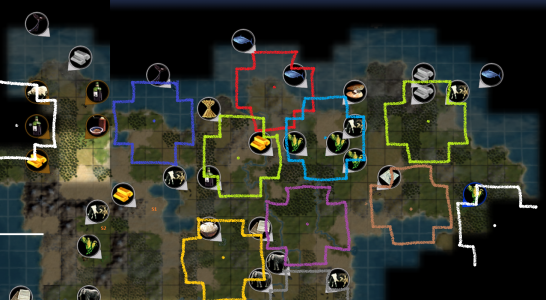VegaDelalyre
Chieftain
- Joined
- Aug 16, 2025
- Messages
- 4
Hi, I'm a Civ II-holic and it's been zero days since I played Civ.
I'm trying to understand how to place cities in Civ4 and came up with this layout. My capital city would be the blue one, but this raises questions:
Edit: proper(er) English.
I'm trying to understand how to place cities in Civ4 and came up with this layout. My capital city would be the blue one, but this raises questions:
- Would 3 maizes + 1 cow + 1 clam be a waste? Should I leave some for a neighbouring city?
- I'm thinking of building my second city on the right side, outlined in lime, so as to start blocking the white competitor. Is that a good strategy?
- How to block my western neighbour? There's a cow by the lake, but then I won't be exploiting the gold west of my capital city. There's also a whale a bit closer to my soon-to-be enemy, but it'll only be exploitable later on.
- Finally, there's a convenient mountain range in the lower-left corner, that would help block the western guy, but it's surrounded by desert and would make for a poor city placement (S1 or S2), wouldn't it?
Edit: proper(er) English.
Attachments
Last edited:


 on water tiles). Such a city would be a fantastic great person pump later on, but therein lies the key: Later on. Early on you will need to share that food in order to use all of it, so it will be worth looking into sharing that food with at least one other city - the clam in particular, since a landlocked city can't make the best use of it long term.
on water tiles). Such a city would be a fantastic great person pump later on, but therein lies the key: Later on. Early on you will need to share that food in order to use all of it, so it will be worth looking into sharing that food with at least one other city - the clam in particular, since a landlocked city can't make the best use of it long term. at a ridiculous, close to 1:2 ratio (2 production per food). That means that then a tile with 5
at a ridiculous, close to 1:2 ratio (2 production per food). That means that then a tile with 5 . Once every 10 turns this whipping unhappiness is reduced by one. Thus a city whipping a lot will quickly stack up unhappiness, meaning that food is better distributed to allow more cities to whip, but at a slower pace (once every 10 turns is good).
. Once every 10 turns this whipping unhappiness is reduced by one. Thus a city whipping a lot will quickly stack up unhappiness, meaning that food is better distributed to allow more cities to whip, but at a slower pace (once every 10 turns is good). ).
).
